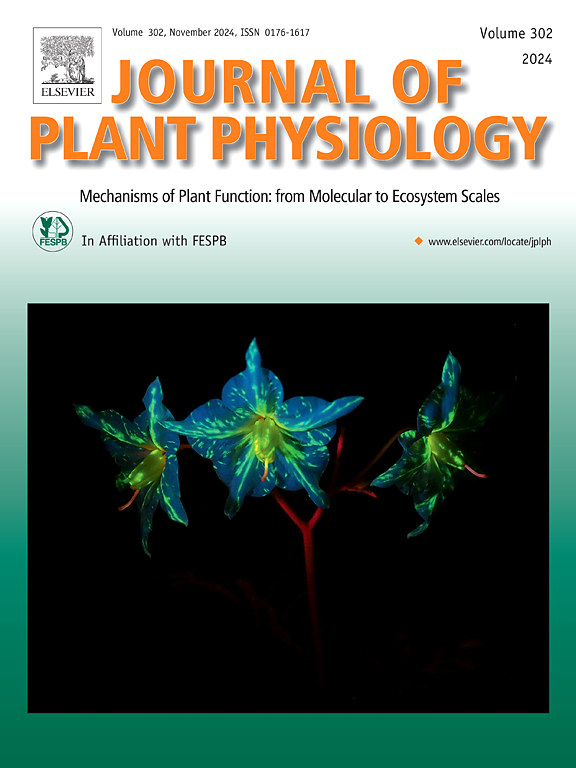Comprehensive genetic dissection of yield-related traits utilizing quantitative trait loci sequencing approach in mungbean
IF 4.1
3区 生物学
Q1 PLANT SCIENCES
引用次数: 0
Abstract
Mungbean [Vigna radiata (L.) R. Wilczek] has gained significant popularity in the food industry, due to its distinctive functional properties and exceptional nutritional value. Increasing yield is a central objective in mungbean breeding programs; however, systematic studies identifying quantitative trait loci (QTLs) associated with key yield-related traits remain limited. In this study, the recombinant inbred line (RIL) population (AH20 × SX36) was generated, and phenotypic assessments were conducted in three distinct environments. Three methods genome-wide composite interval mapping (GCIM), multiple QTL mapping (MQM) and inclusive composite interval mapping (ICIM) were employed to detect QTLs linked to HSW (hundred-seed weight), SPP (number of seeds per pod), PL (pod length), PW (pod width), and YP (yield per plant). Consequently, 33, 19, 26, 22, and 20 QTLs were identified for HSW, SPP, PL, PW, and YP, respectively. Notably, 10 QTLs were consistently detected across all environments and by all three mapping methods, indicating their robustness and potential for breeding applications. Candidate genes associated with these stable QTLs were also predicted, offering insights into the genetic regulation of yield traits. These findings provide a valuable genetic framework for functional validation and the cultivation of high-yielding mungbean germplasm.
利用数量性状位点测序方法对绿豆产量相关性状进行综合遗传剖析
绿豆[Vigna radiata [L.]R. Wilczek]由于其独特的功能特性和特殊的营养价值,在食品工业中获得了显著的普及。提高产量是绿豆育种计划的中心目标;然而,系统地识别与关键产量相关性状相关的数量性状位点(qtl)的研究仍然有限。本研究生成重组自交系(RIL)群体(AH20 × SX36),并在三种不同环境下进行表型评估。采用全基因组复合区间作图(GCIM)、多QTL作图(MQM)和包容性复合区间作图(ICIM) 3种方法检测与百粒重(HSW)、单荚数(SPP)、荚果长(PL)、荚果宽(PW)和单株产量(YP)相关的QTL。结果表明,HSW、SPP、PL、PW和YP分别鉴定出33、19、26、22和20个qtl。值得注意的是,10个qtl在所有环境和所有三种定位方法中都被一致检测到,表明它们的稳健性和育种应用潜力。预测了与这些稳定qtl相关的候选基因,为产量性状的遗传调控提供了见解。这些发现为功能验证和高产绿豆种质资源的培育提供了有价值的遗传框架。
本文章由计算机程序翻译,如有差异,请以英文原文为准。
求助全文
约1分钟内获得全文
求助全文
来源期刊

Journal of plant physiology
生物-植物科学
CiteScore
7.20
自引率
4.70%
发文量
196
审稿时长
32 days
期刊介绍:
The Journal of Plant Physiology is a broad-spectrum journal that welcomes high-quality submissions in all major areas of plant physiology, including plant biochemistry, functional biotechnology, computational and synthetic plant biology, growth and development, photosynthesis and respiration, transport and translocation, plant-microbe interactions, biotic and abiotic stress. Studies are welcome at all levels of integration ranging from molecules and cells to organisms and their environments and are expected to use state-of-the-art methodologies. Pure gene expression studies are not within the focus of our journal. To be considered for publication, papers must significantly contribute to the mechanistic understanding of physiological processes, and not be merely descriptive, or confirmatory of previous results. We encourage the submission of papers that explore the physiology of non-model as well as accepted model species and those that bridge basic and applied research. For instance, studies on agricultural plants that show new physiological mechanisms to improve agricultural efficiency are welcome. Studies performed under uncontrolled situations (e.g. field conditions) not providing mechanistic insight will not be considered for publication.
The Journal of Plant Physiology publishes several types of articles: Original Research Articles, Reviews, Perspectives Articles, and Short Communications. Reviews and Perspectives will be solicited by the Editors; unsolicited reviews are also welcome but only from authors with a strong track record in the field of the review. Original research papers comprise the majority of published contributions.
 求助内容:
求助内容: 应助结果提醒方式:
应助结果提醒方式:


